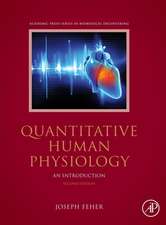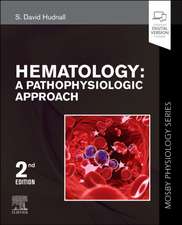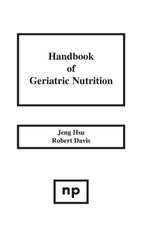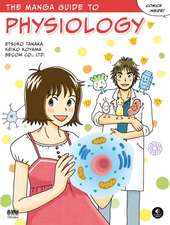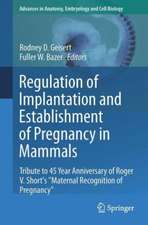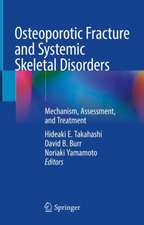Skeletal Tissue Mechanics
Autor R. Bruce Martin, David B. Burr, Neil A. Sharkey, David P. Fyhrieen Limba Engleză Hardback – 3 noi 2015
This book also:
Maximizes reader insights into the mechanical properties of bone, fatigue and fracture resistance of bone and mechanical adaptability of the skeleton
Illustrates synovial joint mechanics and mechanical properties of ligaments and tendons in an easy-to-understand way
Provides exercises at the end of each chapter
| Toate formatele și edițiile | Preț | Express |
|---|---|---|
| Paperback (1) | 601.79 lei 6-8 săpt. | |
| Springer – 3 noi 2015 | 601.79 lei 6-8 săpt. | |
| Hardback (1) | 765.15 lei 38-44 zile | |
| Springer – 3 noi 2015 | 765.15 lei 38-44 zile |
Preț: 765.15 lei
Preț vechi: 805.41 lei
-5% Nou
Puncte Express: 1148
Preț estimativ în valută:
146.43€ • 151.95$ • 122.39£
146.43€ • 151.95$ • 122.39£
Carte tipărită la comandă
Livrare economică 13-19 martie
Preluare comenzi: 021 569.72.76
Specificații
ISBN-13: 9781493930012
ISBN-10: 149393001X
Pagini: 342
Ilustrații: XV, 501 p.
Dimensiuni: 155 x 235 x 27 mm
Greutate: 1.16 kg
Ediția:2nd ed. 2015
Editura: Springer
Colecția Springer
Locul publicării:New York, NY, United States
ISBN-10: 149393001X
Pagini: 342
Ilustrații: XV, 501 p.
Dimensiuni: 155 x 235 x 27 mm
Greutate: 1.16 kg
Ediția:2nd ed. 2015
Editura: Springer
Colecția Springer
Locul publicării:New York, NY, United States
Public țintă
GraduateCuprins
Dedication.- Preface.- Functional Musculoskeletal Anatomy.- Skeletal Biology.- Growth, Modeling and Remodeling of Bone.- Mechanical Properties of Ligament and Tendon.- Synovial Joint Mechanics.- Mechanical Adaptability of the Skeleton.- Mechanical Properties of Bone.- Fatigue and Fracture Resistance of Bone.
Notă biografică
Dr. R. Bruce Martin is Professor Emeritus of Orthopaedic Surgery and was a member of both the Biomedical Engineering and Mechanical and Aerospace graduate groups of the University of California, Davis. Prior to his retirement, he was the Director of the Lawrence J. Ellison Musculoskeletal Research Center. He is well known for his work employing computation modeling of bone remodeling dynamics and its application to the pathogenesis of stress fractures and negative feedback systems associated with the development of osteoporosis.
Dr. David Burr is a Distinguished Professor at Indiana University, holding appointments in Anatomy and Cell Biology in the School of Medicine, and in Biomedical Engineering at Indiana University-Purdue University, Indianapolis (IUPUI). He currently serves as the Associate Vice Chancellor for Research at IUPUI. Dr. Burr has been a leader in understanding the role of skeletal fatigue and mechanical adaptation of bone and cartilage. Dr. Burr isa Fellow of the American Association of Anatomists. He was presented with the Borelli Award by the American Society of Biomechanics in 2008, and was the recipient of the Henry Gray Scientific Achievement Award from the American Association of Anatomists in 2015.
Dr. Neil Sharkey is a Professor of Kinesiology, with additional appointments in Orthopedics and Rehabilitation and the Huck Institutes of the Life Sciences at the Pennsylvania State University. He is currently the Vice President for Research at Penn State, having previously served as Associate Dean for Research in the College of Health and Human Development on the University Park campus. Dr. Sharkey’s research is focused on musculoskeletal biology and biomechanics, with a body of work that includes both basic science projects as well as applied studies with immediate clinical relevance. He is perhaps best known for his biomechanical models of lower extremity function in health, injury and disease.
Dr. David P.
Fyhrie is a Professor of Orthopaedic Surgery and Biomedical Engineering at the University of California, Davis. He is a Fellow of the American Association for the Advancement of Science and of the American Institute for Medical and Biological Engineering. He currently serves as Program Director of the Biomechanics and Mechanobiology Program for the National Science Foundation. He is known for his work applying mathematical modeling to both osteoporotic fracture prediction and adaptation of bone to load and also for experimental work on the microstructural mechanisms of bone failure.
Dr. David Burr is a Distinguished Professor at Indiana University, holding appointments in Anatomy and Cell Biology in the School of Medicine, and in Biomedical Engineering at Indiana University-Purdue University, Indianapolis (IUPUI). He currently serves as the Associate Vice Chancellor for Research at IUPUI. Dr. Burr has been a leader in understanding the role of skeletal fatigue and mechanical adaptation of bone and cartilage. Dr. Burr isa Fellow of the American Association of Anatomists. He was presented with the Borelli Award by the American Society of Biomechanics in 2008, and was the recipient of the Henry Gray Scientific Achievement Award from the American Association of Anatomists in 2015.
Dr. Neil Sharkey is a Professor of Kinesiology, with additional appointments in Orthopedics and Rehabilitation and the Huck Institutes of the Life Sciences at the Pennsylvania State University. He is currently the Vice President for Research at Penn State, having previously served as Associate Dean for Research in the College of Health and Human Development on the University Park campus. Dr. Sharkey’s research is focused on musculoskeletal biology and biomechanics, with a body of work that includes both basic science projects as well as applied studies with immediate clinical relevance. He is perhaps best known for his biomechanical models of lower extremity function in health, injury and disease.
Dr. David P.
Fyhrie is a Professor of Orthopaedic Surgery and Biomedical Engineering at the University of California, Davis. He is a Fellow of the American Association for the Advancement of Science and of the American Institute for Medical and Biological Engineering. He currently serves as Program Director of the Biomechanics and Mechanobiology Program for the National Science Foundation. He is known for his work applying mathematical modeling to both osteoporotic fracture prediction and adaptation of bone to load and also for experimental work on the microstructural mechanisms of bone failure.
Textul de pe ultima copertă
This textbook describes the biomechanics of bone, cartilage, tendons and ligaments. It is rigorous in its approach to the mechanical properties of the skeleton yet it does not neglect the biological properties of skeletal tissue or require mathematics beyond calculus. Time is taken to introduce basic mechanical and biological concepts, and the approaches used for some of the engineering analyses are purposefully limited. The book is an effective bridge between engineering, veterinary, biological and medical disciplines and will be welcomed by students and researchers in biomechanics, orthopedics, physical anthropology, zoology, and veterinary science.
This book also:
Maximizes reader insights into the mechanical properties of bone, fatigue and fracture resistance of bone, and mechanical adaptability of the skeleton
Illustrates synovial joint mechanics and mechanical properties of ligaments and tendons in an easy-to-understand way
Provides exercises at the endof each chapter
This book also:
Maximizes reader insights into the mechanical properties of bone, fatigue and fracture resistance of bone, and mechanical adaptability of the skeleton
Illustrates synovial joint mechanics and mechanical properties of ligaments and tendons in an easy-to-understand way
Provides exercises at the endof each chapter
Caracteristici
Maximizes reader insights into the mechanical properties of bone and mechanical adaptability of the skeleton Illustrates synovial joint mechanics and mechanical properties of ligaments and tendons in an easy-to-understand way Provides exercises at the end of each chapter Request lecturer material: sn.pub/lecturer-material

